How Iron Technology Changed the Ancient World and Gave the Philistines a Military Edge
040
041
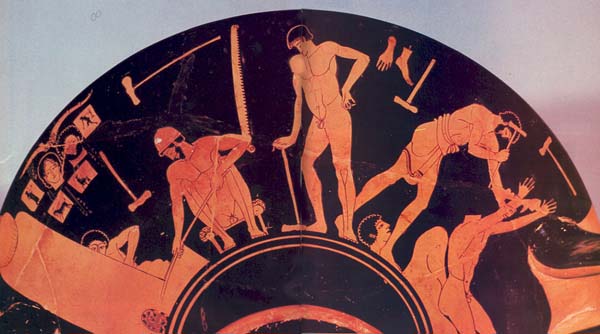
042
Modern historians divide the roughly 3,000 year-period beginning approximately 3200 B.C. into two major segments—the Bronze Age and the Iron Age. The Bronze Age I extends from about 3200 B.C. to 1200 B.C.a Thereafter it is the Iron Age.b This is some indication of the enormous importance (as well as the date generally) of the discovery of iron technology in the eastern Mediterranean.
Archaeology and modern science are now beginning to clarify how this fundamental change occurred, and in so doing a new dimension has been added to our understanding of Biblical history in general as well as to our understanding of particular Biblical passages.
As a result, we may even be able to answer the much-mooted question: Did the Philistines have an iron monopoly that enabled them, at least for a time, to dominate the Israelites? Answering this question will involve us in a consideration of the famous passage from 1 Samuel:
“There was no smith to be found in all the land of Israel, for the Philistines had said to themselves, ‘The Hebrews might make swords or spears!’ So all Israel would go down to the Philistines to repair any of their plow shares, mattocks, axes or sickles. The price was a palm for plowshares and mattocks and a third of a shekel for 043picks and axes or setting an ox-goad. So at the time of the battle of Michmash neither sword nor spear was available to any of the soldiers who were with Saul and Jonathan—only Saul and Jonathan had them.” (1 Samuel 13:19–22; Anchor Bible translation)
Until about 1200 B.C., bronze was the predominant metal in the ancient world—for a very simple reason. The melting point of copper is about 1100° C. The melting point of iron is 1530° C. This roughly 400° difference was crucial in terms of the capabilities of ancient technology.
From at least the fifth millennium B.C. copper was worked as a molten metal.c In the fourth millennium, an arsenical alloy of copper was developed in the Middle East. This alloy usually contained from two to four percent arsenic. The best examples of this alloy come from the famous hoard of over 400 copper objects from the cave of Nahal Mishmar on the west bank of the Dead Sea.
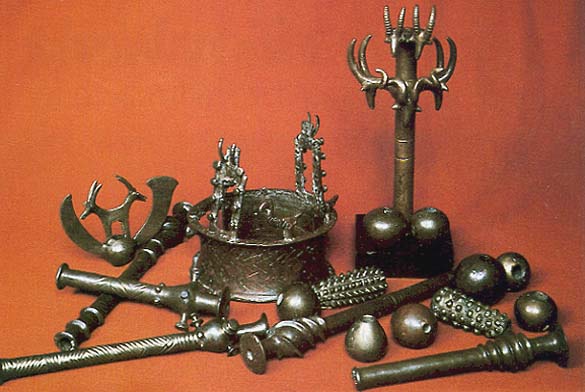
The Bronze Age, beginning in about 3200 B.C., witnessed the introduction of an alloy known as bronze, consisting of about 90 percent copper and 10 percent tin. During the Bronze Age, an elaborate bronze casting technology was developed. Many bronze casting molds have been found throughout the Bronze Age world, often matching the surviving objects cast from them. The entire casting operation is depicted on the walls of Egyptian New Kingdom tombs, the most famous of which is that of the vizier Rekhmire (first half of the 15th century B.C.). Larger objects were sometimes cast in the sand, rather than in molds, as we know from the Bible passage describing Hiram’s manufacture of the bronze utensils to be used in Solomon’s Temple.
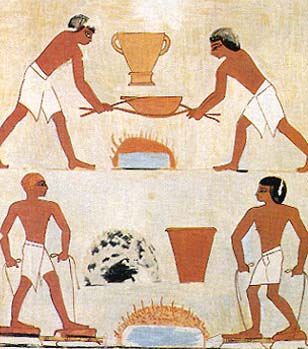
“All these furnishings made by Hiram for King Solomon for the Temple of Yahweh were of burnished bronze. He made them by the process of sand casting in the Jordan area between Succoth and Zorethan.” (I Kings 7:45–46, Jerusalem Bible translation)
A temperature of 1200°C to melt copper could be attained in an ancient furnace by the use of a bellows and tuyèresd that supplied the necessary forced draft of air. But the melting point of iron, 1530°C, seems to have been beyond the capability of an ancient furnace.
This does not mean that iron was not used at all. On the contrary, iron objects are known from as early as the fifth millennium B.C. But until the coming of the Iron Age, iron was an exotic, semi-precious metal used, for example, in jewelry. We even have examples of an iron bezel in a gold ring from Late Bronze Age Greece. Iron was also used for the manufacture of ceremonial weapons. An iron battle axe from Ugarit (about 1400 B.C.) and a dagger from the tomb of Tutankhamen in Egypt (about 1350 B.C.) are examples.
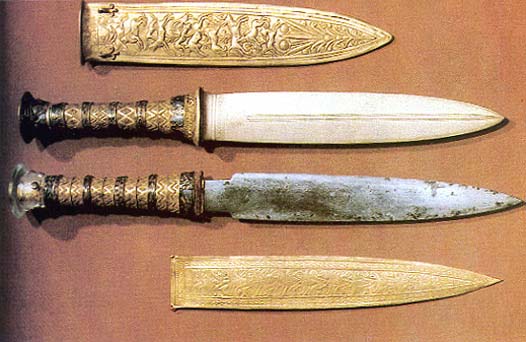
These early iron objects were not cast, because the iron could not be heated to a molten state; instead they were wrought. The iron was forged, after smelting, while it was in a semi-solid spongy state.
Pure iron worked in this way is not very utilitarian. Indeed, plain wrought iron is decidedly inferior to tin-bronze, being both softer and less durable. The work-hardened edge on a bronze cutting instrument is far superior to anything that can be produced in plain wrought iron.
Thus for the 2,000 years of the Bronze Age (3200–1200 B.C.) bronze was the predominant metal in the ancient world. This is especially ironic, if I may be pardoned the pun, because iron was so much more widely dispersed than copper. But, from the viewpoint of Bronze Age technology, these vast iron deposits were relatively worthless.
Moreover, not only was copper less common than iron, but tin, the second component of bronze, was indeed quite scarce. In the Mediterranean world, alluvial tin, or cassiterite, is known from the Eastern Desert of Egypt. While there is geological evidence for its presence in these areas, there is no evidence of its ancient exploitation. Apart from Egypt, alluvial tin is known only from regions as far away as southern England (Cornwall) in the West and Afghanistan in the East. The Biblical reference to tin from Tarshish (Ezekiel 27:12) is not very helpful in locating ancient tin deposits because we cannot locate Tarshish.
At the end of the Late Bronze Age, there was a worldwide upheaval of destructions, invasions and migrations. 044Whether the crises were related to one another is unknown. But these upheavals plunged the world into a Dark Age of poverty and isolation. This was the time when Troy was destroyed, when the Dorians moved into Greece from the northwest, when the Phrygians migrated to Anatolia, when the Sea Peoples, including the Philistines, attacked (but were repelled by) Egypt and finally settled on the Palestine coast, and when the Israelites occupied Canaan. At this time, Mycenaean sea power ended, the Hittite empire collapsed, the great city-states in Syria were destroyed, and the Arameans migrated into Mesopotamia and Syria. These destructions marked the end of the great empires of the Late Bronze Age and of the palace economies that developed around the urban centers associated with these empires.
The Late Bronze Age, until the very end, had been a time of prosperity and extensive international trade. Late Bronze Age levels of excavations, wherever they are located, characteristically uncover substantial quantities of “imported” pottery, frequently painted and decorated. But all this came to an end in the waning years of the Late Bronze Age. International trade routes were permanently disrupted and local communities withdrew into themselves. No longer could vast supplies of copper, and especially tin, be brought over long distance by land and sea. During the Bronze Age, according to the most recent scholarship, the tin used in Middle Eastern bronze came all the way from Afghanistan. Although the proof for this statement has not been fully supplied, it does suggest the kinds of production problems that ensued following the disruption of international commerce. Copper supply dwindled and tin became almost unavailable.
In the archaeological levels from the first part of the Iron Age, precious metals are no longer found and imported materials are extremely rare. There were, of course, areas where Bronze Age culture, including metalworking, survived, but this was the exception, not the rule.
As is so often the case in human history, necessity became the mother of invention. While bronze was easily available, there was no necessity for the development of iron technology. In short, the inception of the Iron Age came about in response to a materials shortage, a crisis created by the disruption of international trade routes. When bronze became scarce, those smiths living in areas that had not been invaded and devastated were forced to fall back on local resources and to make do with what was available nearer to home. Iron metallurgy developed against this background.
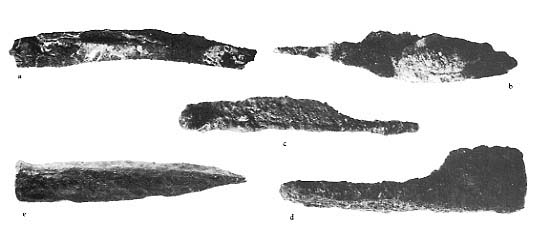
Not only were iron deposits more likely than copper to be available locally, but iron was more easily extracted from the earth. Iron ore deposits, even when found in association with copper deposits, tend to be on the surface and therefore their extraction does not require any elaborate mining technology. Copper ores, on the other hand, tend to be located in veins running deep into the ground and often require a network of underground shafts and galleries in order to be mined. Archaeologists have found a number of early copper mines, some going back to the fifth millennium B.C., but no ancient iron mines, perhaps because iron was mined on the surface.
The famous Biblical description of the riches of the Promised Land reflects the fact that copper mining requires underground shafts and galleries but iron mining utilizes 045surface deposits. In addition to its agricultural wealth, the land of Canaan was “a land where the stones are of iron, where the hills may be quarried for copper.” (Deuteronomy 8:9, Jerusalem Bible translation). Actually, ancient Palestine has only limited deposits of iron ore,e but the Biblical author accurately described the conditions under which the two metals could be found.
While local accessibility and ease of extraction might be thought to have given iron the edge (again, excuse the pun), only the scarcity of bronze provided the goad for the development of iron technology.
Perhaps this is understandable because iron technology is difficult and complicated. As we have seen, in antiquity iron could not be heated to the melting point, so it had to be wrought or forged in a semi-solid spongy mass (or bloom, as it is called). Moreover, this porous mass of agglomerated iron had trapped within its interstices quantities of impurities called gangue, consisting basically of silica. In order to consolidate the metal, it was necessary to hammer or forge the red-hot bloom, thus forcing out or extruding the unwanted gangue. But even when this was done, the resultant pure iron was soft compared to bronze.
The essential factor in the technological development of iron metallurgy was the introduction of up to .8 percent carbon into the red-hot iron, accomplished by a kind of osmosis through prolonged contact with glowing charcoal in the forging furnace. The introduction of this carbon transformed iron from an exotic, semi-precious metal into a metal that would give its name to the age. For carburized iron (iron to which carbon has been added) is, in fact, steel.
The technology is not simple, however. When red-hot carburized iron (or steel) is suddenly cooled off by plunging it into a vat of cold water (quenching), the result includes the formation of material called martensite. Martensite is earth’s second-hardest substance. Only a diamond is harder. The problem is that martensite, though extremely hard, is also very brittle. An object of pure martensite will shatter upon impact.
When carburized iron is quenched, however, the result is not pure martensite. Usually only the outer layers of the object will be converted into martensite; the inner layers will be composed of pearlite, consisting of alternate layers (or lamellae) of ferrite (pure iron) and cementite (a compound of iron and carbon). Just how much martensite will be produced depends upon mass and temperature.
In order to relieve the brittleness of the metal, it was necessary to reduce some of the martensite through tempering; that is, reheating the iron, at temperatures above 150°C, in order to decompose some of the martensite and 046thus reduce the brittleness of the metal. This resulted in an elaborate trade-off of hardness versus durability that became the hallmark of advanced iron metallurgy.
The technology of working with iron thus became far more complex than anything connected with copper or bronze, and it all had to be learned empirically. No Iron Age smith was aware even of the existence of carbon, an element not identified until the end of the 18th century A.D.; he only learned empirically of its effect. But once these ancient smiths learned that iron subjected to the elaborate heat-treatment of carburization, quenching and tempering was far superior to bronze, a new age was ushered in. Iron was no longer a curiosity but one of the most useful resources in the crust of the earth.
The Iron Age became the age of the blacksmith. The village blacksmith standing at his forge before an anvil, holding a lump or bar of red-hot iron in a pair of tongs, was a metalworking scene unknown to the inhabitants of the Bronze Age world. But this scene became common when iron emerged as the dominant metal, largely replacing the casting technology used for copper and bronze.
A vivid artistic representation of a smithy appears on a sixth century B.C. amphora from Athens. An assistant, who is partially obscured by a furnace, holds a red-hot bar of metal with a pair of tongs while the blacksmith stands in front of the anvil, raising a sledge-hammer with a wedge-shaped head, ready to strike the bar. Two bearded men holding staffs sit and respectfully observe. Lying on the floor and hanging on the wall are a saw, tongs, a vase, a garment, a knife, a chisel, a sheathed sword and sledge-hammers with wedge-shaped heads and with double concave heads.
The first recorded reference to the profession of blacksmith comes in an archival text from the reign of the Assyrian king Ninurta-tukulti-Assur, about 1132 B.C.1
The work of the blacksmith is vividly described in the Bible. For example, in Isaiah 44:12, we learn about the manufacture of iron idols:
“The blacksmith works on it over the fire and beats it into shape with a hammer. He works on it with his strong arm til he is hungry and tired; drinking no water, he is exhausted.” (Jerusalem Bible translation)
The same image is projected in Ecclesiasticus 38:29–31, part of a section dealing with trade and crafts:
“So it is with the blacksmith sitting by his anvil;
he considers what to do with the iron bloom,
the breath of the fire scorches his skin,
as he contends with the heat of the furnace;
he batters his ear with the din of the hammer,
his eyes are fixed on the pattern;
he sets his heart on completing his work,
and stays up putting the finishing touches.”
(Jerusalem Bible translation, but reading “iron bloom” instead of “pig iron”)
Indeed, the red-hot iron furnace came to be used metaphorically for Egypt, from which God delivered the Israelites. Solomon prays to Yahweh on behalf of his people: “They are your people and your heritage whom you brought out of Egypt, that iron furnace.” (1 Kings 8:51; Jerusalem Bible translation). The image is repeated in Deuteronomy 4:20 and in Jeremiah 11:4.
Bronze of course continued to be used in the Iron Age, especially for purposes for which iron was unsatisfactory. The basic difference between bronze and iron technology determined, to a very great extent, the ways in which the two metals were used. With bronze it was possible to make large, elaborate and intricate castings from the molten metal in shapes impossible to duplicate by forging a bar of iron. A life-size statue was almost commonplace in bronze, but unheard of in iron. Iron came to be used for objects of rather simple shape and design, requiring great hardness and strength. This meant cutting and chopping instruments such as axes, adzes and chisels,f digging instruments such as hoes and plowshares, and, above all, weapons. Because of its hardness and its ability to take and hold a sharp cutting edge or point, iron was ideal for swords, spearheads, knives, daggers, and even arrowheads. Thus, iron soon became the metal of war, producing the iron armory described in Job 20:24. But all of this was possible only with the use of carburized iron (or steel) and the development of a technology involving quenching and tempering.
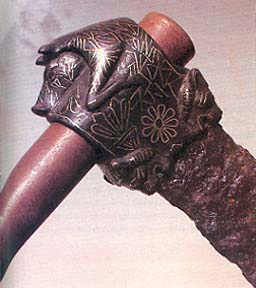
In the Bible, iron is a symbol of strength. In Job 40:18 we are told of Behemoth, the brute whose bones are “as hard 047as hammered iron.” And in Daniel 2:40 we read the prophecy of the four kingdoms:
“There will be a fourth kingdom, hard as iron, as iron that shatters and crushes all. Like iron that breaks everything to pieces, it will crush and break all the earlier kingdoms.” (Jerusalem Bible translation)
The sharpness of the edge of an iron dagger is assumed in these lines from a Babylonian Wisdom text known as The Dialogue of Pessimism2: “Woman is a pitfall—a pitfall, a hole, a ditch. Woman is a sharp iron dagger that cuts a man’s throat.”
The problem of tracing the development and spread of iron technology should be an ideal one for archaeology in combination with modern science. More than 40 years ago, R. J. Forbes, then the world’s leading specialist in ancient technology, observed: “If there ever was a problem of ancient metallurgy in which the technical aspect can give us the correct solution it is that of the coming of the Iron Age.”3
Today, archaeologists in cooperation with metallurgists, can discover a great deal of information from a small metal sample taken from an ancient iron artifact. After the archaeologist excavates an iron object, the modern metallurgist can determine hearth temperatures reached at the different stages of production such as forging or tempering. 048From a study of the penetration of carbon into the iron object, the metallurgist can make rough calculations of the length of time the object was held in the charcoal fire and even at what temperature in order to achieve that particular carbon penetration. Very recently we have learned to use even corrosion product in new analytical techniques developed at the University of Pennsylvania. The problem is that permission to take the necessary samples from ancient artifacts has proven quite difficult to obtain. Some modern countries refuse to authorize such research because it involves taking a small sample of metal from the ancient artifact. The exceptions are Israel and Cyprus.
For the past five years Professors Robert Maddin and Tamara Stech and I (all colleagues at the University of Pennsylvania) have been working together on a detailed program involving the scientific study of early metal artifacts throughout the eastern Mediterranean, concentrating on objects that could be dated within the limits of the crucial transition period from 1200 to 900 B.C. (from the end of the Bronze Age to the full Iron Age). Metallurgical analyses of individual artifacts have added significantly to the largely archaeological surveys that follow. After five years of study, we can state that iron technology probably first developed in the Eastern Mediterranean, with Greece and Cyprus playing the dominant roles, and that the introduction of iron metallurgy into Israel came about through contacts with the Aegean world and the migrations of the Philistines and other Sea Peoples.
The development of iron metallurgy occurred in areas where a surviving tradition of Bronze Age metalworking was combined with an ability to respond to the new pressures of a difficult, even hostile environment. This can clearly be seen in the Aegean, where the concentration of 12th century iron artifacts comes from just those areas where the Late Bronze Age Mycenaean heritage is most apparent, areas that somehow managed to avoid the devastations and destructions that marked the end of the Late Bronze Age throughout the eastern Mediterranean. Examples are the sites of Perati in East Attica, Mouliana in Crete, Lefkandi in Euboea and the Kamini cemetery on the island of Naxos.
With the introduction of a strong Aegean element into Cyprus, probably the result of the arrival of Greek colonists in the early 12th century B.C., comes the first use of iron on Cyprus, followed there by the rapid development of iron technology. Again, this occurs at Cypriot sites, such as Kition, that maintained strong elements of continuity with the culture of the Late Bronze Age, and at sites in the 049southwestern part of the island that witnessed the first arrival of the Greek colonists.
The influence of these Greek colonists can be seen in the pottery and the architecture as well as in the iron artifacts of 12th century Cyprus. Contemporaneous iron objects from Cyprus and from the Aegean suggest a common cultural and ironworking heritage for that area. For instance, consider the one-edged curved knife of iron having a hilt of bone or ivory fastened with three bronze rivets, examples of which have been found at numerous eastern Mediterranean sites. The combination of metals may be a result of the fact that bronze rivets, unlike iron ones, could be cold-worked, thus preventing damage to the delicate ivory hilt. But the combination suggests a certain continuity between bronze and iron cultures and supports the contention that iron technology developed in areas where Bronze Age culture, including a bronze metalworking industry, survived.
Such iron knives with bronze rivets have been found in 12th to early 11th century contexts throughout the Aegean and the eastern Mediterranean, from Perati in Attica to Hama in Syria, almost alwaysg uncovered in association with typical Mycenaean IIIC1 pottery of the 12th century B.C. (or its local imitations). Such an iron knife was recently found at the Philistine site of Tell Qasile, again in a 05012th century B.C. context and at a site having very strong connections with Cyprus, especially Kition, and with the Aegean.
From the so-called “500” cemetery at the Philistine site of Tell el-Fariah (south), another site with strong Aegean connections, come several 12th century B.C. iron objects, including a dagger from Tomb 542. We have not studied this dagger, but an iron knife with one bronze rivet from Tomb 562, dating from the 11th century B.C., proved to be made of carburized iron presenting a metallurgical structure that strongly suggested deliberate carburization.
From Cyprus we have even better evidence for the development of a sophisticated iron technology. In 1971 the Swedish metallurgist Erik Tholander analyzed a curved iron knife from a tomb at Idalion and found it to be made of quench-hardened steel. We have now confirmed Tholander’s results, working with another sample from the same knife, and have at the same time greatly expanded the evidence for the use of carburized iron from sites scattered all over the southern half of the island, including Kouklia-Skales (Palaepaphos), Amathus, Idalion and Kition, as well as from Lapithos in the north. All this evidence for carburization comes from 11th century B.C. contexts.
We have very little metallurgical evidence for the state of ironworking technology in the 12th century B.C. We do have a number of surviving iron objects from Canaanite, Philistine, and Israelite sites,4 but with two exceptions, no scientific studies have been carried out on any of these 12th century pieces. One exception is a knife from Tell Qasile which proved, unfortunately, to be totally corroded. The other exception is somewhat extraordinary—an iron pick found in 1976 by a young Israeli archaeologist, David Davis, excavating on behalf of the Israeli Department of Antiquities at Har Adir, near Sasa in the Upper Galilee. The iron pick is in a remarkable state of preservation and clearly dates to the early 12th, perhaps even the 13th century B.C. We are working with the excavator on the publication of this pick, which to date remains unpublished, but even now we can state that our metallurgical analysis of the iron indicates that the manufacturer of the pick had knowledge of the full range of ironworking skills associated with the production of quench-hardened steel. The pottery from the site associated with the pick reflects close connections with the island of Cyprus.
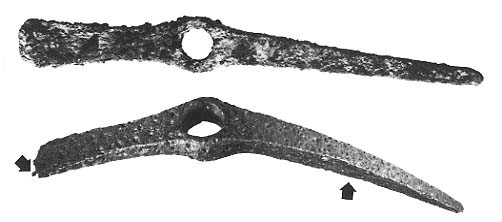
Thus the 12th and 11th century iron objects that have been found throughout the eastern Mediterranean all come from sites that have in common an international milieu, and more particularly some sort of contact with the Aegean and Cyprus. The archaeological evidence also indicates some degree of continuity, perhaps even the survival of metalworking traditions, from the more sophisticated world of the Late Bronze Age. The only exceptions to these general propositions are the Early Israelite sites located just to the north of Jerusalem Ai, Khirbet Raddana, and Tell el-Ful (ancient Gibeah where an 11th century iron plowshare was found). At these sites iron appears in a context independent of any evidence for contact with the outside world. They also represent new settlements with no Bronze Age metalworking traditions.
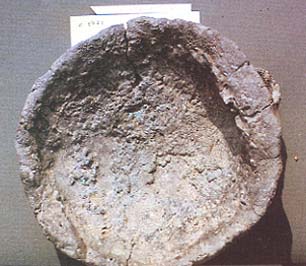
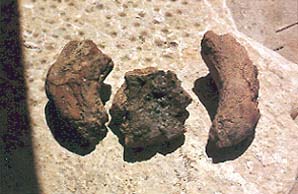
An essentially Bronze Age culture continued to survive in the Aegean at a number of sites—the Ionian islands, the southeastern part of the Greek mainland (eastern Attica and Euboea), and in some of the larger islands such as Crete, Rhodes and Naxos. This was also true in Cyprus. In Palestine this same continuity can be seen in the northern Canaanite cities, like Megiddo (stratum VIIA) and Taanach (period IB) in the Jezreel Valley, and at Beth-Shean (stratum VI).h
Both in the northern and central parts of Palestine, the Israelites were initially limited to the occupation of isolated sites in the hills (such as Izbet Sartah)i because they could not conquer the rich cities in the plain below. The sons of Joseph complained to Joshua that:
“The highlands are not enough for us, and what is more, all the Canaanites living in the plain have iron chariots, and so have those in Beth-Shean and its 051dependent towns, and those in the plain of Jezreel.” (Joshua 17:16, Jerusalem Bible translation)
Joshua replied that:
“A mountain shall be yours; it is covered with woods, but you must clear it, and its boundaries shall be yours, since you cannot drive out the Canaanite because of his iron chariots and his superior strength.” (Joshua 17:18, Jerusalem Bible translation)
This tradition is found throughout the Conquest narratives. The Israelites, as a loose confederation of tribes, lacked the military technology necessary to conquer the fortified Canaanite cities of the plain. The technological superiority of the Canaanites is dramatized in this passage from Joshua by the emphasis upon their possession of “chariots of iron.” Jabin, the king of Canaan who reigned at Hazor, is said to have possessed a force that included 900 chariots of iron. (Judges 4:3)
These passages from Joshua and Judges referring to “iron chariots” and “chariots of iron” present some problems—both metallurgical and chronological. No one actually had chariots of iron. The Jerusalem Bible translates one passage of Judges 4 as chariots “plated with iron.” In Joshua, it translates simply “iron chariots.” The translation “plated with iron” is really an interpretation without textual support. The words “plated with” were simply supplied by the translator. It is extremely difficult to plate with iron. These “chariots of iron” must be regarded as a poetical and psychological description of the latest in military hardware, combining chariots, the most formidable aspect of all Late Bronze Age armies, with iron, the latest addition to the military arsenal and a metal that was just starting to make its impact upon the military world of the Early Iron Age. The actual use of iron must have been confined to fittings, such as the hubs of the chariot’s wheels, perhaps even parts of the wheel itself. (The same explanation probably applies to the iron bedstead of Og, king of Bashan, in Deuteronomy 3:11.) Such iron chariot fittings have been recovered at Taanach, but unfortunately in an uncertain archaeological context.
The chronological problem unsolved in these Biblical references to chariots of iron is that they appear to date to the 12th century at the latest. The excavator of Hazor, Yigael Yadin, dates the Israelite destruction of Hazor to about 1230 B.C. A 13th century date for this destruction is now universally accepted.j Yet the use of iron for offensive weapons cannot be documented before the 12th century, and really not before the 11th. Perhaps in one way or another, the Conquest Narratives describe the world of the 12th to early 11th century B.C., although some events may have occurred earlier.
In any event the present evidence indicates that iron technology developed in Palestine in the 12th century at the earliest, stimulated by the arrival of the Philistines and other Sea Peoples who brought with them the inspiration, and perhaps even the new technology from the Aegean area. We have already examined the evidence for the development of iron technology in the Aegean area as well as the impressive recent evidence for the extensive use of iron in 12th to early 11th century Cyprus.
Trude Dothan has recently examined in these pages the Aegean origins of the Philistines.k We may therefore be brief here: According to the Bible the Philistines came from Caphtor (Amos 9:7), long identified as the Biblical name for the island of Crete. Other traditions (Zephaniah 2:5 and Ezekiel 25:16) link the Philistines with the Cherethites, identified as Cretans. The connections between Cyprus and the Philistines are most apparent in the characteristic Philistine style of pottery. The Aegean elements in Philistine pottery, long recognized as being influenced by Mycenaean IIIC1 ceramic traditions, clearly 052came not from Greece itself, but from the local imitations of Mycenaean wares produced at 12th century B.C. sites in Cyprus. Amihai Mazar has recently excavated three superimposed Philistine temples at Tell Qasile dating from the first half of the 12th century to the middle of the 11th century. (Drawings of plans of these temples appear in “What We Know About The Philistines,” BAR 08:04.) He also uncovered a favissa of cult objects associated with the second of the three temples. There are very close connections between these Philistine temples and the Philistine cult objects, on the one hand, and a series of so called shrines or temples excavated recently in Cyprus (Kition), the Greek Islands (Phylakopi or Melos) and the Greek mainland (Mycenae), on the other hand. Thus it seems reasonable to conclude that the Philistines introduced advanced iron technology into Palestine. What still remains unclear is the formative history of that technology.
In a recent issue of BAR, Yohanan Aharoni argued that “thus far no substantial archaeological evidence indicates that iron had been widely used in Philistia before it was widely used at Israelite sites.”l This statement in fact misses the point. Aharoni failed to distinguish between the kinds of iron artifacts found at Philistine and Israelite sites. Philistine political control of the area of southern Palestine dates from the end of the 12th century B.C. at the earliest. Iron artifacts from the 11th century are to be found at Israelite as well as Philistine sites, but all of the weapons—swords, daggers, spearheads—are found at Philistine sites.
This archaeological picture is entirely consistent with the literary tradition preserved in 1 Samuel 13:19–22, quoted at the beginning of this article. In this passage we are told that there were no smiths in the land of Israel because the Philistines were fearful that the Hebrews might make swords or spears. So the Israelites had to come to the Philistines to get their farm implements repaired.
Aharoni rightly points out that the Biblical passage makes no mention of iron—nor of an ironworking monopoly for that matter. But the Israelites obviously had metal 053farm implements that needed repairing. On the basis of the surviving artifactual evidence, it is reasonable to assume that, by the end of the 11th century B.C. (the time of the reign of Saul), these farm implements were made of iron.
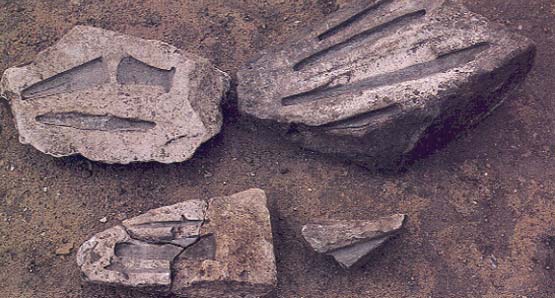
In contrast to the farm implements found at Israelite sites, an important collection of 11th century iron objects, including three daggers and five knives, has been found at Tel Zeror, a site with strong Cypriot connections in the Late Bronze Age. Tel Zeror also had close connections with the Sea Peoples at nearby Tell Dor, known from the Wenamun tale to have been inhabited by the Tjekker (one of the Sea Peoples). Indeed, the inhabitants of Tel Zeror may well have been Sea Peoples (perhaps Philistines).
Aharoni has argued that the absence of iron artifacts in Philistine levels at Ashdod, the most important Philistine site to be excavated in modern times, indicates that the Philistines had no role in the development of early iron metallurgy. This overlooks the fact that at Tel Mor, which served as the harbor for ancient Ashdod, Moshe Dothan (who also excavated Ashdod) found extensive evidence for 12th century B.C. metalworking activity, including tuyèes, crucibles and copper spatter, the bits and droplets of copper that fall out when molten copper is poured into a crucible.m True, this all relates not to iron, but to the casting of molten copper, but it indicates the sort of background usually associated with the development of iron metallurgy. Dothan also found iron slag from the 10th century B.C. In addition, at Ashdod itself, Dothan found a single-edged knife from about 1000 B.C. and a large blade-like object and an axe from the end of the 10th century B.C.
What is puzzling—and still difficult to understand—is the distribution of carburized as opposed to noncarburized iron. For example, the iron objects from Philistine Ashdod mentioned above are not carburized at all.
We have analyzed iron objects from several other sites in Palestine, but unfortunately these objects do not include the 12th to early 11th century iron objects from Megiddo. At Taanach, we did extensive work on 10th century iron objects; most showed some degree of carburization. Yet the evidence was not consistent and objects that one would have expected to be made of steel, such as a chisel, were made of wrought iron. Of the two plowshares from Taanach that we examined, one was made of carburized iron, the other was not. We have no explanation for this inconsistency. At Tell Jemmeh, near Gaza, a site we would naturally associate with the Philistines, iron objects probably dating to the 10th century (although some modern investigators date them later) show little or no evidence of carburization. These objects, along with the ones from Ashdod, certainly provide no support for any claim to Philistine superiority in the technology of ironworking. Yet the 11th century iron knife from Tomb 562 at Tell el-Fariah (south) showed evidence for carburization, while two others from the contemporaneous Tomb 220 did not—again the same inconsistency as at Taanach. From Tomb 240, probably of the 10th century, an iron dagger presented excellent evidence for carburization.
Clearly, our sample base is still too small to provide data for meaningful conclusions. We can present good arguments for the role of the Philistines in the early development of iron technology, but these arguments can, at present, only be supported, not substantiated by the existing analytical evidence.
Having looked at the objects themselves, let us now consider what little evidence we have relating to ironworking installations. It is sad but true that until the last 20 or 25 years most field archaeologists focused their attention on the excavation of monumental public and administrative buildings, on religious and ceremonial centers, and on cemeteries where there was a good chance of finding rich burial goods. Thus, we still know little about domestic architecture and the routine of daily life, and practically nothing about the industrial centers of the ancient world. Moreover, sometimes what are in fact pottery kilns for firing pottery have been mistakenly described as metalworking installations. Published examples of this error include the so called “furnaces” from Beth Shemesh stratum IV (room 490) and stratum III (room 441), and from Tell Deir Alla (phase B).n
In the early part of this century, Sir Flinders Petrie excavated some “furnaces” at Tell Jemmeh near Gaza. These furnaces probably date to the 9th to 8th centuries B.C. As Petrie correctly observed, they were forging furnaces, not smelting furnaces. It would be helpful to know more about these discoveries, but unfortunately Petrie published only the briefest account and nothing is left of the remains at the present time.
During the first excavations at Megiddo, 1903–1905, Gottlieb Schumacher identified a blacksmith’s workshop consisting of a small room very likely from the Solomonic period. Again, few details were published, apart from references to the discovery of ash and slag and a substance 054identified as iron ore. Associated with the workshop was a hoard of iron artifacts including a hoe (a), a plowshare (b), and an ox-goad (c). This hoard is very similar to the one from Taanach that we have studied, but, alas, the Megiddo hoard seems to have vanished, so there is no possibility of subjecting it to metallurgical analysis.
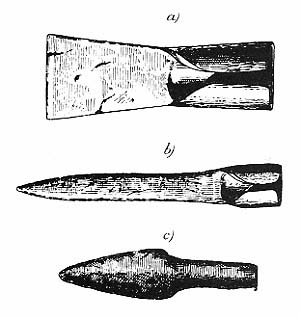
To summarize and conclude, the evidence is strong that iron technology developed in the Aegean and was probably brought to Palestine by the Sea Peoples, and perhaps by the Philistines themselves. Based on excavated evidence, it appears that the Philistines did have a monopoly of sorts on ironworking, as reflected in the passage from 1 Samuel. Iron weapons are found at Philistine sites only; at Israelite sites we find iron agricultural implements, as reflected in the literary tradition preserved in the Bible.
In my view, however, the Philistine ironworking monopoly was political, not technological. What is described in the passage from 1 Samuel is not a Philistine technological monopoly supported by metalworking secrets known only to the Philistines. At least at the present, we have no evidence of Philistine ironworking technological superiority; indeed, the evidence regarding deliberate carburization of iron at Philistine sites is inconsistent, some artifacts showing deliberate carburization and others, quite late, showing no carburization. The restrictions imposed on the Israelites could thus only have been accomplished as a result of Philistine political control. In order to overthrow Philistine political domination, the tribally organized Israelites finally agreed to band together, to elect Saul as king, and to present a united front against the Philistine pentapolis. Finally, in the early 10th century, King David broke the dominion the Philistines had exercised over much of Palestine.
Our analysis indicates that a common typology of iron artifacts is found throughout Palestine, dating at the latest to the end of the 10th century B.C. But at this point in our research we cannot say whether there was a common ironworking technology. At present, the scientific evidence for the early history of ironworking technology is confined to Cyprus and Israel, and even there it is incomplete and inconsistent. We know much more than we did five years ago, but we still have much to learn. We know nothing, for example, about the early period of ironworking in Greece, Turkey or Syria. We have not examined a single piece of iron from Lebanon and we are just beginning to learn something about iron technology in Jordan.
Clearly what is needed is a major international research project designed to explore all facets of the history of early ironworking throughout the ancient world. Until now, our group at the University of Pennsylvania has supplied the entire body of existing scientific evidence relating to ironworking in the eastern Mediterranean during the years 1200–800 B.C. We have, I believe, demonstrated the enormous potential of this research. Whether our project will grow and expand, whether our efforts will encourage other scholars to undertake work in this field remains to be seen.
But we have already advanced beyond the time when Biblical scholars could analyze passages like 1 Samuel 13:19–22 in blissful ignorance of everything except philology. The Biblical authors had a multi-faceted view of their world—of its domestic and industrial life as well as its monuments and ceremonies. It is time that modern scholars attempt to reach the same level of competence. We must strive to recreate, through all the means at our disposal, a world that was taken for granted by its contemporary inhabitants.
042 Modern historians divide the roughly 3,000 year-period beginning approximately 3200 B.C. into two major segments—the Bronze Age and the Iron Age. The Bronze Age I extends from about 3200 B.C. to 1200 B.C.a Thereafter it is the Iron Age.b This is some indication of the enormous importance (as well as the date generally) of the discovery of iron technology in the eastern Mediterranean. Archaeology and modern science are now beginning to clarify how this fundamental change occurred, and in so doing a new dimension has been added to our understanding of Biblical history in general as well […]
You have already read your free article for this month. Please join the BAS Library or become an All Access member of BAS to gain full access to this article and so much more.
Already a library member? Log in here.
Institution user? Log in with your IP address or Username
Footnotes
The Bronze Age is subdivided into Early Bronze (3200–2000 B.C.), Middle Bronze (2000–1550 B.C.) and Late Bronze (1550–1200 B.C.). Each of these is also further subdivided.
The Iron Age is subdivided into Iron Age I (1200–1000 B.C.), Iron Age II (1000–586 B.C.), and, sometimes, Iron Age III (586–330 B.C.).
Pure copper metallurgy developed to a high degree, not only in the old world from Eastern Europe to Pakistan but even in North America.
A tuyère is an opening in a furnace through which a blast of air enters, facilitating combustion.
There are a number of minor deposits—in the Makhtesh southwest of the Dead Sea, in the Galilee and in the Wadi Arabah—but the only major ore deposit is that at Mugharat el Wardeh in the vicinity of Ajlun, about 20 miles north-northwest of Amman, a deposit that would be exploited today were it not so inaccessible.
See 13th century B.C. iron sickle illustrated in “The Israelite Occupation of Canaan,” BAR 08:03.
See “The Israelite Occupation of Canaan,” BAR 08:03, by Yohanan Aharoni.
See “An Israelite Village from the Days of the Judges,” BAR 04:03, by Aaron Demsky and Moshe Kochavi.
See Aharoni, “The Israelite Occupation of Canaan,” BAR 08:03.
See Dothan, “What We Know About the Philistines,” BAR 08:04.
See Aharoni, “The Israelite Occupation of Canaan,” BAR 08:03.
Our analysis of this material led to the conclusion that Tel Mor served as a recycling or reprocessing center for the impoverished bronze industry of the 12th century B.C.
The “furnaces” at Tell Deir Alla have been related to the passage in 1 Samuel 13:19–22, as representing one of the places where the Israelites went down to have their metal implements repaired, but the published plans indicate that what was excavated there were pottery kilns of the channel type, best known from second millennium sites on the island of Crete.
Endnotes
Ernst Weidner, “Ausden Tageneines assyrischen Schattenkonigs,” Archiv fur Orientforschung, Vol. X, pp. 148.
W. G. Lambert, Babylonian Wisdom Literature, Oxford University Press, 1960, pp. 146–147, lines 51–52.
R. J. Forbes, “The Coming of Iron,” Jaarbericht … Ex Orient Lux, 910 (1944–48 [1952], pp. 207–14.
